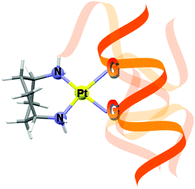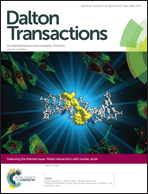DNA fragment conformations in adducts with Kiteplatin†
Abstract
The anticancer activity of cisplatin is triggered by its formation of intrastrand adducts involving adjacent G residues of DNA. To obtain information on the different conformers that can be formed, carrier ligands such as 2,2′-bipiperidine, which provide large steric bulk near the platinum coordination plane and decrease the dynamic motion about the Pt–N7 bonds, were introduced (“retro-modelling” approach). In the present study we investigate the effect of cis-1,4-diaminocyclohexane (cis-1,4-DACH) on the formation, stability, and stereochemistry of (cis-1,4-DACH)Pt(ss-oligo) adducts (ss-oligo = d(GpG) with 3′- and/or 5′-substituents). Interesting features of this ligand, absent in previous retro-modelling studies, include the large bite angle (expected to impede the ease of interconversion between possible conformers), the presence of two protons on each nitrogen (a characteristic associated with antitumor activity), and the absence of chiral centres. The use of cis-1,4-DACH has made it possible to detect different conformers in a system containing a primary diamine carrier ligand associated with anticancer activity and to confirm the previous hypothesis that the coexistence of different conformers established in studies of retro models having relatively bulky ligands is not an artefact resulting from carrier-ligand bulk. Moreover, the data for the (cis-1,4-DACH)Pt(d(GpG)) and (cis-1,4-DACH)Pt(d(GGTTT)) adducts indicate that at a temperature close to the physiological one (40 °C) HH1 and ΔHT1 conformers are present in comparable amounts. In contrast, at low temperature (close to 0 °C) the equilibrium shifts dramatically toward the more stable HH1 conformer (for the (cis-1,4-DACH)Pt(d(TGGT)) adduct the HH1 conformer is always dominant, even at high temperature). Notably, (cis-1,4-DACH)PtCl2 (Kiteplatin) has been recently reinvestigated and found to be particularly active against colorectal cancer (including oxaliplatin-resistant phenotypes).

- This article is part of the themed collection: Metal Interactions with Nucleic Acids

 Please wait while we load your content...
Please wait while we load your content...